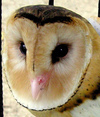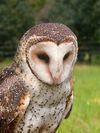Genus Tyto
Common barn-owl - The Barn Owl is the most widely distributed species of owl, and one of the most widespread of all birds. It is also referred to as Common Barn Owl, to distinguish it from other species in the barn-owl family Tytonidae. These form one of the two living main lineages groups of owls, the other being the typical owls . T. alba is found almost anywhere in the world outside polar and desert regions, as well as all of Asia north of the Alpide belt, most of Indonesia, and the Pacific islands.
Bismarck Masked-Owl - As with other tropical barn owls, it is difficult to spot in the wild and therefore poorly studied. It is likely to be a lowland forest species.
Grass Owl - The African Grass Owl Tyto capensis is considered Vulnerable in South Africa, with between 1 000 and 5 000 birds remaining in this country , 2000). The species is extirpated in south-western South Africa and Lesotho, and the combined pressure from development; fire mismanagement; land clearing for agriculture; overgrazing; afforestation and roadkill are of serious concern for the species .
Minahassa Owl - The Minahassa Masked Owl has short wings with wingspan of 240-250 mm well suited to its habitat in deep forests. It appears to prefer undisturbed or lightly disturbed rainforest at an altitude of 100-1,600 m. As the primary lowland forests on the Minahasa peninsula has been destroyed, the survival of the species depends on the more inaccessible montane forests. The species is known to inhabit the two large protected regions established in central Sulawesi and Minahassa Peninsula. The remaining population is estimated to be 2,500 – 10,000.
Australasian Grass-Owl - Though some authorities consider this owl to be conspecific with the African Grass-owl, T. capensis, other consider it to be a valid species.
Manus Masked-Owl - It is a poorly-known forest-dwelling species, which is rarely seen. Comparison with the closely related Australian Masked Owl indicates it is likely to have large territories, and the population may be smaller than 1000.
Australian Masked-Owl - Described subspecies of Tyto novaehollandiae include:
Lesser Masked-Owl - The Moluccan Masked Owl , also known as the Lesser Masked Owl, Effraie Des Tanimbar or Lechuza De Las Tanimbar, is a species of owl in the Tytonidae family. It is endemic to Indonesia.
Madagascar red owl - The Madagascar Red Owl resembles the cosmopolitan Barn Owl but is smaller and has orange plumage with small black spots. It is known to live in humid evergreen forest in the east of the island, being found in primary forest and in disturbed secondary forest . It feeds on native mammals like tenrecs and tuft-tailed rats . It nests in tree-cavities, although there is only one record of a nest being found.
Sooty Owl - The Sooty Owl , also known as the Greater Sooty Owl, is a medium to large owl found in south-eastern Australia, Montane rainforests of New Guinea and have been seen on Flinders Island in the Bass Strait. They have a finely white spotted head with scattered white spots on the wings. The females are lighter colored than the males. The females length is 37-43 cm and weighs 750-1000 gm. The male is smaller and length is 37-43 cm and weighs 500-700 gm. The wing length is 30-40 cm. The large dark eyes are set in a round large facial disk. The facial disk is dark gray silver or sooty black and has a heavy black edge. The upper part of the owl is black to dark gray and the under part is lighter. Their call is a piercing shriek which can last up to two seconds. The tail is short and the legs are feathered large black talons. They are nocturnal and hide in hollow tree trunks, caves and in tall trees with heavy foliage.



